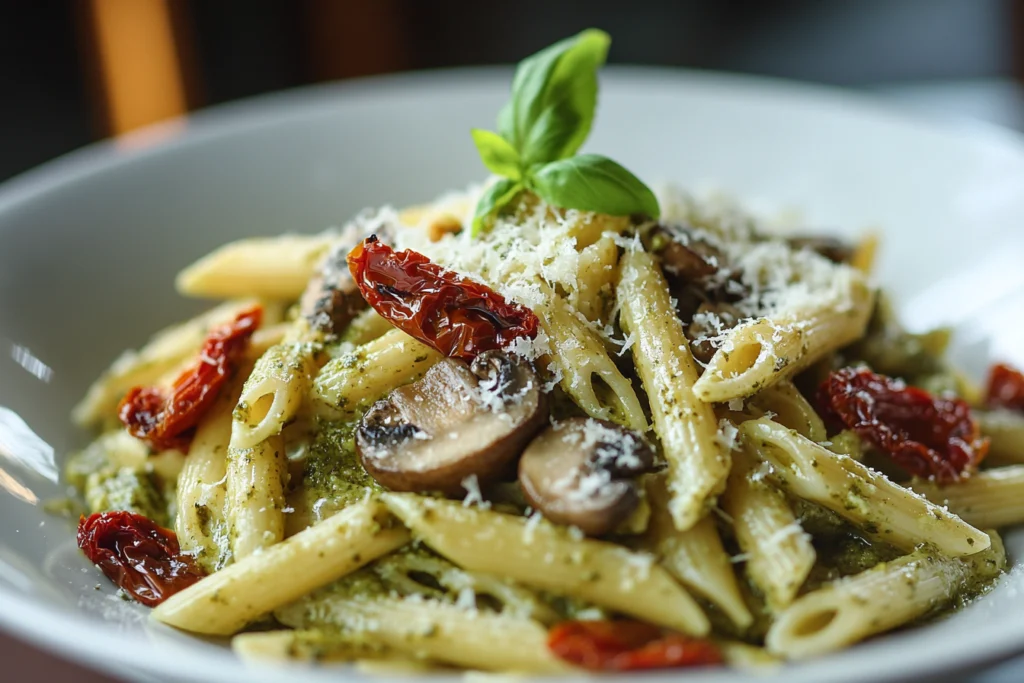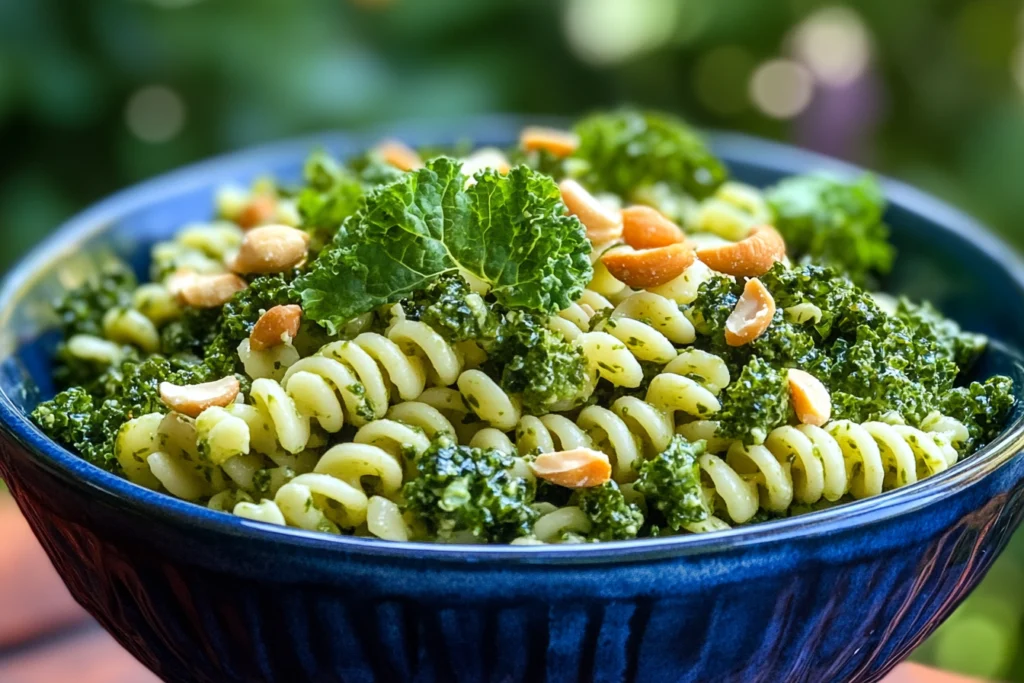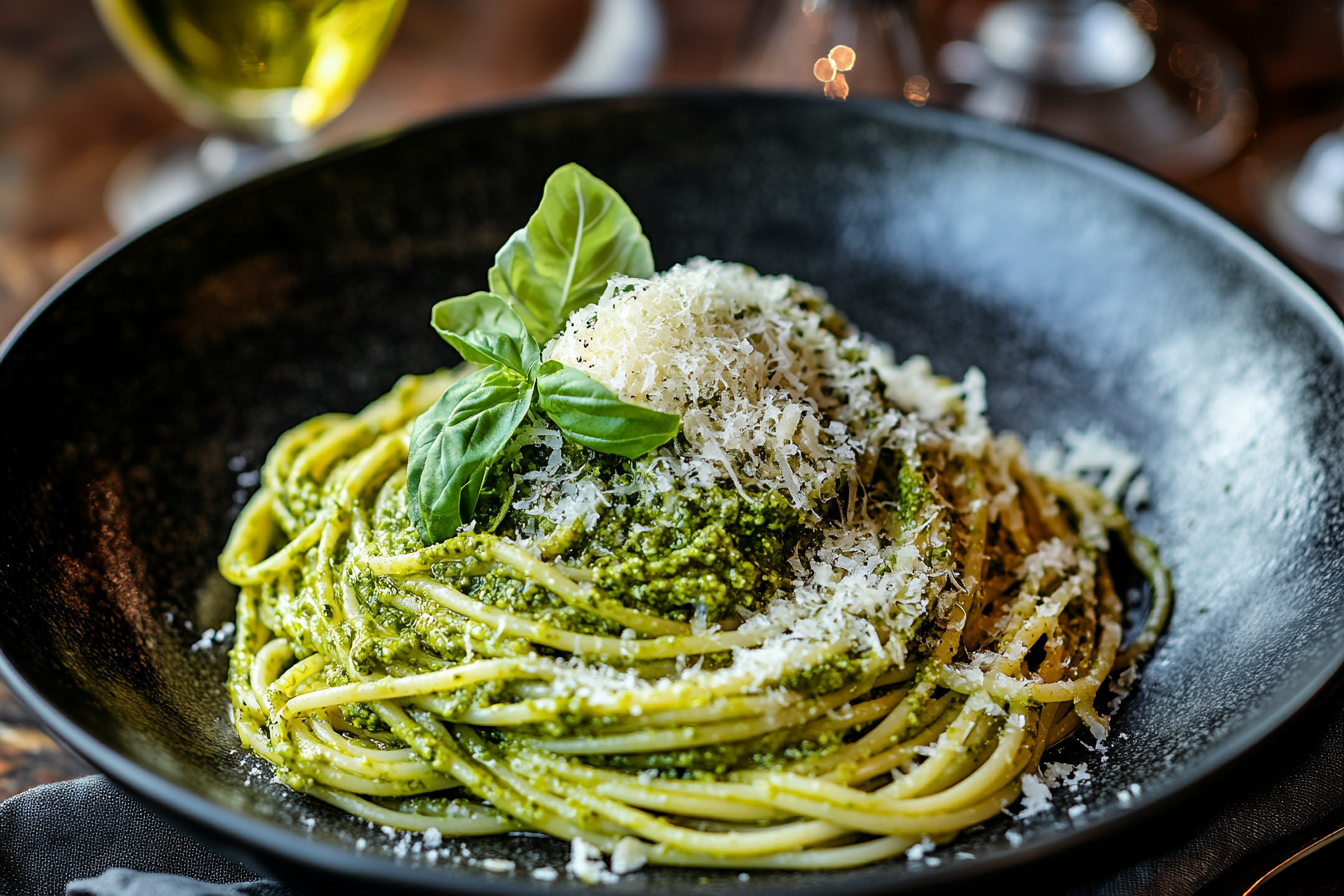What Is Traditionally Served with Pesto Pasta?
Pesto pasta is an iconic dish that blends the fresh, vibrant flavours of basil, pine nuts, Parmesan cheese, garlic, and olive oil. Its rich yet simple composition makes it a versatile option for various culinary pairings. What dishes traditionally accompany pesto pasta? To fully savour this delightful meal, pairing it with complementary sides, proteins, cheeses, and beverages is key. In this guide, we’ll consider traditional accompaniments that can increase your pesto pasta experience.
Traditional Ingredients in Pesto Pasta
The foundation of pesto pasta lies in its authentic Italian roots. Each ingredient contributes to its bold, herbaceous flavour profile. To begin with, here’s what makes up a classic pesto pasta:
- Basil: Fresh basil is the star of the dish, offering a sweet and slightly peppery taste.
- Pine Nuts: These provide a creamy texture and nutty undertones.
- Parmesan Cheese: Adds a salty, umami-rich flavour.
- Garlic: Infuses the dish with aromatic depth.
- Extra Virgin Olive Oil: Binds all ingredients while delivering a fruity richness.
In short, to assure the best results, use high-quality, fresh ingredients. The simplicity of the recipe allows these elements to shine.
Classic Accompaniments for Pesto Pasta
When exploring what is traditionally served with pesto pasta, classic accompaniments often include simple yet flavorful sides that complement its earthy tones. For example:
- Fresh Salads: A crisp green salad with arugula, spinach, or mixed greens drizzled with lemon vinaigrette balances the richness of pesto.
- Crusty Bread: A warm loaf of ciabatta or focaccia is perfect for mopping up any remaining sauce.
- Roasted Vegetables: Zucchini, cherry tomatoes, or bell peppers roasted with olive oil and herbs increase the meal’s vibrancy.
Ultimately, these sides maintain the dish’s Mediterranean essence while adding texture and balance.
Protein Pairings for Pesto Pasta
To create a hearty and satisfying meal, pair pesto pasta with proteins that harmonize with its herbal flavour. Traditionally, options include:
- Grilled Chicken: Lightly seasoned chicken breasts or thighs complement the dish without overpowering it.
- Shrimp: Sautéed shrimp adds a touch of sweetness, enhancing the savoury pesto sauce.
- Seared Salmon: The rich, fatty texture of salmon works beautifully with the nutty notes of pesto.
As a rule of thumb, for a more traditional experience, opt for proteins seasoned simply to allow the pesto to remain the highlight. To learn more about protein pairings, check out our article on what meat pairs well with pesto pasta.
Cheese Pairings with Pesto Pasta
Cheese is a cornerstone of Italian cuisine and a wonderful addition to pesto pasta. Beyond that, several cheeses pair well:
- Mozzarella: Fresh mozzarella provides a creamy, mild contrast to the boldness of pesto.
- Pecorino Romano: This salty sheep’s milk cheese intensifies the savoury notes.
- Ricotta: Whipped ricotta adds a velvety, slightly sweet element.
To sum up, offering a variety of cheese pairings allows diners to customize their plates.
Side Dishes to Hoist the Meal
Beyond salads and bread, other side dishes can bring creativity to your pesto pasta meal. For instance:
- Caprese Skewers: Cherry tomatoes, fresh mozzarella, and basil on skewers are visually appealing and delicious.
- Stuffed Mushrooms: Fill portobello mushrooms with garlic, breadcrumbs, and cheese for a savoury side.
- Garlic Green Beans: Lightly sautéed green beans with garlic and olive oil offer a crunchy complement.
By doing so, these side dishes enrich the meal while staying true to the flavours of Italian cuisine.
Vegetarian and Vegan Options
For those seeking plant-based alternatives, there are plenty of ways to enjoy pesto pasta while keeping it vegan-friendly or vegetarian. To illustrate:

- Tofu or Tempeh: Marinated and grilled, these proteins absorb the pesto flavour perfectly.
- Vegan Parmesan: Substitute traditional cheese with a nut-based or nutritional yeast alternative.
- Roasted Chickpeas: Add texture and protein without compromising on flavour.
In conclusion, vegetarian and vegan options maintain the essence of pesto pasta while catering to dietary preferences.
So, what is traditionally served with pesto pasta? In summary, from fresh salads and crusty bread to grilled chicken and fine wines, the possibilities are vast and flavorful. By thoughtfully selecting sides, proteins, cheeses, and beverages, you can create a balanced and memorable meal that celebrates the best of Italian cuisine. Whether you’re sticking to traditional accompaniments or exploring vegan-friendly options, pesto pasta is a versatile dish that shines in any setting.
This version uses transition words and phrases such as “for example,” “to begin with,” “in conclusion,” and others to guide the reader through the article ideally. Whether you’re sticking to traditional accompaniments or exploring vegan-friendly options, pesto pasta is a versatile dish that shines in any setting.
Regional Variations
Pesto pasta is celebrated worldwide, yet its roots are firmly planted in the Italian tradition. Regional differences in how it is served highlight Italy’s rich culinary diversity. In Liguria, where pesto alla Genovese originated, it is often paired with trofie pasta, a short, twisted variety that clings perfectly to the sauce.
In the southern regions of Italy, pesto pasta might incorporate a spicy twist, with red chilli flakes or the addition of sun-dried tomatoes. Meanwhile, northern Italy leans into creamy variations, blending pesto with mascarpone or ricotta to create a smoother, milder sauce. For more creative ideas, see our article on sausage and pesto pasta tips.
What is traditionally served with pesto pasta?
While Ligurians prefer potatoes and green beans, other regions opt for dishes like focaccia, bruschetta, or a light green salad. These pairings increase the vibrant flavours of the pesto.
- Liguria: Trofie pasta, potatoes, green beans.
- Southern Italy: Sun-dried tomatoes, chilli.
- Northern Italy: Creamy mascarpone or ricotta blends.
Seasonal Variations
Pesto pasta adapts beautifully to seasonal ingredients, showcasing the versatility of fresh produce. In spring, asparagus, peas, and baby spinach complement it, adding a crisp, refreshing bite.
Summer calls for a burst of freshness, with cherry tomatoes, roasted zucchini, and basil at their peak flavour. During autumn, earthy elements like mushrooms, butternut squash, and sage make their way into the dish. Winter variations often incorporate root vegetables, hearty beans, or nuts like hazelnuts for added texture.
What is traditionally served with pesto pasta?
Seasonal sides boost the experience, such as grilled vegetables in summer or roasted root vegetables in winter.
- Spring: Asparagus, peas, baby spinach.
- Summer: Roasted zucchini, cherry tomatoes.
- Autumn: Mushrooms, butternut squash.
- Winter: Hazelnuts, roasted parsnips.
Desserts That Complement Pesto Pasta
Desserts that follow pesto pasta should be light, allowing the herbal notes of basil and garlic to linger. Classic Italian options like panna cotta, flavoured with lemon or vanilla, work wonderfully.
Alternatively, consider sorbet, especially lemon or raspberry, for a palate-cleansing end. For a decadent finish, a light tiramisu with a touch of citrus zest can balance the meal.
What is traditionally served with pesto pasta?
Desserts like fruit tarts or gelato complement the simplicity and freshness of pesto dishes, leaving a satisfying conclusion to the meal.
- Panna cotta: Lemon, vanilla.
- Sorbet: Lemon, raspberry.
- Tiramisu: With citrus zest.
- Gelato: Fruit-flavored or nut-based.
Tips for a Balanced Meal
Achieving a balanced meal with pesto pasta requires thoughtful pairings. Including a source of protein, such as grilled chicken, shrimp, or even chickpeas, can round out the dish.
Add a fibre-rich salad with ingredients like arugula, spinach, and cherry tomatoes, dressed with olive oil and lemon. For a hearty meal, complement the pasta with a small side of whole-grain bread or garlic focaccia.
What is traditionally served with pesto pasta?
Traditional accompaniments like green beans and potatoes provide balance, offering a mix of carbs, vegetables, and textures.
- Protein: Grilled chicken, shrimp, chickpeas.
- Vegetables: Green beans, arugula, spinach.
- Bread: Whole-grain or garlic focaccia.
Looking for creative tips on pairing side dishes? Consider our guide on side dishes to go with chicken nuggets.
Cooking Techniques for Perfect Pesto Pasta
To master perfect pesto pasta, precision is key. Begin by choosing a high-quality pesto, preferably freshly made. Cooking pasta al dente insures it holds its texture and absorbs the sauce without becoming soggy.
When mixing, reserve some pasta water to loosen the sauce, creating a creamy consistency. So avoid overheating the pesto to preserve its fresh, herbal flavour.
What is traditionally served with pesto pasta?

Well-cooked accompaniments like boiled potatoes or steamed green beans pair ideally without overpowering the dish.
- Use fresh pesto for authentic flavour.
- Reserve pasta water for a creamy sauce.
- Cook pasta al dente for the best texture.
Cultural Significance
Pesto pasta is more than a dish; it’s a symbol of Italian heritage. Originating in Genoa, its recipe has been passed down through generations, celebrating the region’s love for simple yet bold flavours.
In Italy, pesto pasta is a communal dish, often shared at family gatherings or festivals. The use of local ingredients like Ligurian olive oil and freshly picked basil reinforces its deep cultural ties.
What is traditionally served with pesto pasta?
In Italian tradition, green beans and potatoes represent simplicity and authenticity, creating a harmonious plate.
- Celebrates Ligurian culinary traditions.
- Reflects the importance of fresh, local ingredients.
- Shared in family and cultural celebrations.
Pesto pasta in conclusion exemplifies the beauty of simplicity with its ability to adapt across regions, seasons, and tastes. Serving pesto pasta with complementary dishes can boost your meal, creating a harmonious blend of flavors and textures.
From regional and seasonal variations to balanced sides and complementary desserts, every detail matters. By mastering cooking techniques and honouring its cultural roots, you can enjoy this timeless dish as the Italians do—with love and authenticity.

